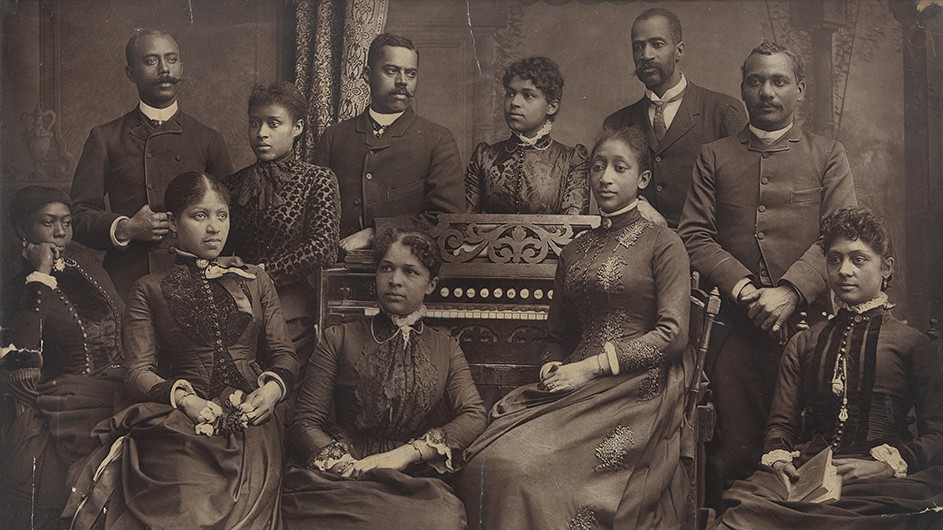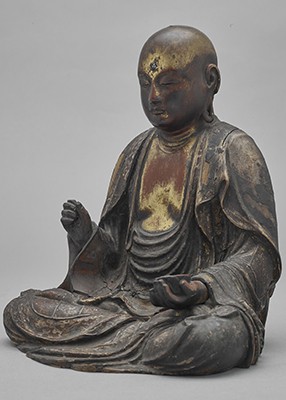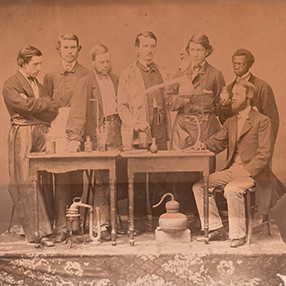The Wallach Art Gallery Presents 3 New Concurrent Exhibitions, All Drawn from Columbia’s Art Collection
The Wallach Gallery is pleased to welcome all vaccinated visitors. The gallery’s public access dates and hours are subject to shifting Covid conditions. In the interest of the health and safety of visitors and staff, details on public access for these exhibitions will be regularly updated on the Wallach’s website. Please check that site for the most up to date information and registration links to visit the exhibitions.

Few people at Columbia realize that the University has a robust art collection. In fact, Columbia has been acquiring art and cultural heritage objects for more than 200 years, almost all of which were gifts and bequests from faculty and alumni. Today the collection comprises more than 13,000 works of art from around the world, from all time periods and cultures in a variety of media. Organized as a special department, Art Properties, in Avery Architectural & Fine Arts Library, the collection supports curricular and educational programs, and encourages opportunities for research and study in all disciplines, from the arts to biomedical sciences.
Three new exhibitions drawn from Art Properties have just opened at the Miriam & Ira D. Wallach Art Gallery. Time and Face: Daguerreotypes to Digital Prints, Object Relations: Indigenous Belongings, and What is the Use of Buddhist Art? are all being presented simultaneously, and are on view through March 12, 2022.
Roberto Ferrari, the curator of Art Properties, and Betti-Sue Hertz, director and chief curator of the Wallach, spoke recently with Columbia News about the exhibitions.
Q. Can you tell us a bit about each of the three new exhibitions on view at the Wallach Art Gallery?
Ferrari: What is the Use of Buddhist Art? is curated by Professor D. Max Moerman, chair of Barnard’s Department of Asian & Middle Eastern Cultures. This exhibition seeks to situate Buddhist objects apart from their conventional categorization as art and more wholly within the rich historical and ritual contexts of their production and use. A selection of ritual texts and objects from Columbia’s C.V. Starr East Asian Library complements the Art Properties works on view.
Object Relations: Indigenous Belongings is curated by artist and critic Alan Michelson, a Mohawk member of the Six Nations of the Grand River. The show considers connections across space and time, pairing work by four contemporary Indigenous women artists—Wendy Red Star, Skawennati, Dakota Mace, and Sonya Kelliher-Combs—with Native American objects in Art Properties from the tribal nations of each artist.
Finally, I curated Time and Face: Daguerreotypes to Digital Prints, which comes from the collection of photographs in Art Properties, and emphasizes the history of portraiture and figurative work in photojournalism and documentary photography. The exhibition is organized in four thematic sections—Time and Technology, Face, Innocence, and Fame—and includes 100 vernacular objects and photographs by major artists, dating from the 1840s to 2010s.

Q. How did these exhibitions come about?
Hertz: When Roberto approached me to inquire about developing an exhibition featuring a selection of works from Art Properties, I immediately understood the value of such a project. I was struck by the fact that Columbia has such a large, rich, and diverse study collection of art, which was not primarily acquired with an intention to display it. The potential of sharing even a fraction of the collection with the public was both purposeful and exciting. We can crack the door open just a little so the public can get a glimpse of what has been tucked away in the storage vaults.
That most of the works in these exhibitions have never had a public viewing made the project even more urgent. With exposure, we can begin to unearth the registers of value in these holdings—from an art history perspective, as cultural heritage, as a portal to a material culture history of Columbia, as well as a monetary asset. In pursuing Roberto’s proposal more thoroughly, I realized that this archive of art contains within it scores of potential exhibitions, special projects, and research topics.
We embarked on many conversations about how to approach this vast collection. I resisted the idea of a highlights show. My curatorial approach, generally speaking, is that exhibitions have the capacity to contribute to dialogues that say something or do something, beyond showing what connoisseurs consider the crème de la crème. What groupings would serve to tell a larger story? What categories of work would be most relevant to our core audiences? I asked Roberto, “Can you name a few of your strongest collections, with a good number of objects that have had little exposure or use?” His answer: “The photography, Buddhist art, and Native American collections.”
We first attempted to present these collections as one exhibition in three parts, but kept running into questions like: Why are we putting these works together under one banner? We needed more flexibility, hence, separating the collections into three distinct shows. Indeed, the curatorial methodology is quite different for each of these exhibitions. Object Relations: Indigenous Belongings was organized by a contemporary artist who saw the value of prioritizing the continuity of culture for specific tribal nations—Apsáalooke (Crow), Kanienʼkehá꞉ka (Mohawk), Diné (Navajo), and Inupiaq—by exhibiting the work of four artists alongside a discrete selection of historical cultural objects.
Professor Moerman, a scholar of Japanese Buddhism with a strong interest in visual culture, posits that understanding the uses of objects as well as the types of spaces they were made for, including temples and caves, will bring them into closer view for visitors to the Wallach. And Roberto, a collections curator, has built Columbia’s photography collection, and was able to include in the exhibition new caches, including, significantly, a selection of daguerreotypes that were acquired in 2019.
This three-exhibition initiative suggests a narrative larger than the sum of its individual parts. Columbia’s history has been told through various accounts, documents, and archived records. But Art Properties is another asset for understanding the institution's history. Art is a special category of material culture, and its safekeeping, stewardship, and study is a first step toward deepening our relationship with cultural history. There are thousands of works of art at the University in dire need of research, scholarship, and updates to existing sources. The works in these exhibitions are testimony to the value of funding such an effort.

Q. What is the rationale behind presenting the exhibitions simultaneously?
Hertz: We may want to ask: What do these clusters of objects have in common with each other? While the objects are visually dissimilar, and are representative of different cultures—Asian, European/American, Native American (with an understanding that these categories are porous)—this group of shows is not as disparate as it may initially appear.
Most of the objects were not made for a museum or gallery setting. Although all the objects on view employ an aesthetic lexicon, they were made in the service of use and function—from the utilitarian to the sacred, from the representational to the symbolic—and embedded in their forms is the why of their making and existence. A pair of blue-beaded Crow moccasins (undated, maker unknown); a small, lacquered, and gilded wooden seated monk made for ritual in 13th-century Japan (maker unknown); and a vernacular daguerreotype photograph from the mid-19th century inside a velvet lined case are all objects made for a specific pragmatic purpose. Each has a use for an individual, and serves to connect that person to their cultural community.
Experiencing these objects on display within a university gallery, and communicating their intended locations—on a woman’s feet, within a domestic altar, or stowed in a drawer except for special viewings—might appear to imply that they are objects better suited to a cultural history museum. But that’s only if you want to tell a historical story. What about the story of the object itself among other objects with which it resonates? By placing these exhibitions side by side, we complicate audience reception. By experimenting with contiguous viewing, my bet is that viewers will gain new insights into these works and unbind them from their imposed cultural categories.

Q. Are there any especially distinctive works on display that you can highlight?
Ferrari: One of the more exciting discoveries in Time and Face, connecting portraiture to the history of collecting at Columbia, is a rare salted paper print from around 1857-60, which depicts the first five students who studied chemistry at Columbia with their professor, Charles Arad Joy, and a young Black lab technician. This work was part of Professor Charles F. Chandler’s Chemical Museum, which he started in the 1870s as a study collection that later occupied parts of Havemeyer Hall for decades. The chemical properties of photomechanical reproduction were important to Chandler, and the result of his interest makes Columbia one of the earliest institutions to begin collecting photography, long before places like the Metropolitan Museum of Art ever did. From a portraiture and history perspective, however, one of the tragedies of this same photograph is that while all five students and their professor are known, we cannot, despite ongoing, extensive research, identify the Black youth, who presumably was a University employee. His loss of identity is an act of erasure that can be seen as part of institutional systemic racism.
Hertz: In What Is the Use of Buddhist Art? there is a small wooden stupa on loan from Columbia’s C.V. Starr East Asian Library, which contains a printed incantation in its central chamber. Produced between 764 and 770, it is an early example of a multiple. One million of them were produced and distributed to temples by an 8th-century Japanese empress to quell a military revolt. Within the context of an art gallery that often exhibits works of contemporary art, it is thrilling to feature one of the earliest known examples of an art multiple, purposefully made for mass distribution.
I’m also fascinated by the mid-19th-century, wooden Mohawk cradleboard in Object Relations: Indigenous Belongings. When worn, the decorative carved and painted floral pattern on the baby carrier, a combination of Indigenous and Western imagery, faces the woman’s back. The entire board’s patterning is visible only when it is not in use. In contemporary artist Skawennati’s 2017 machinima video, The Peacemaker Returns, a cradleboard, an iconic Native American cultural object, makes a cameo appearance. It is a simple symbolic vehicle signaling the continuity of culture.